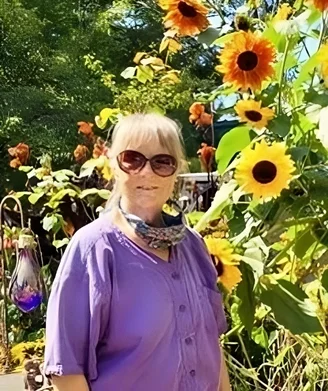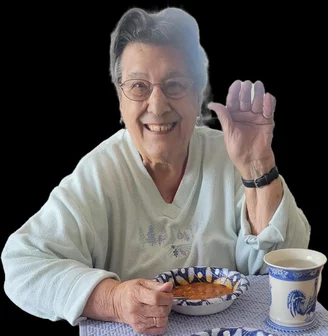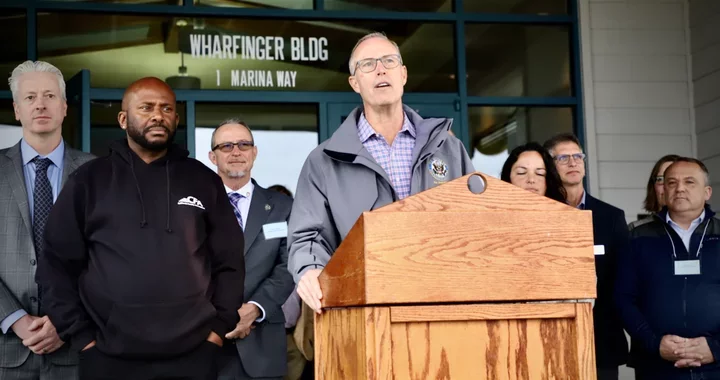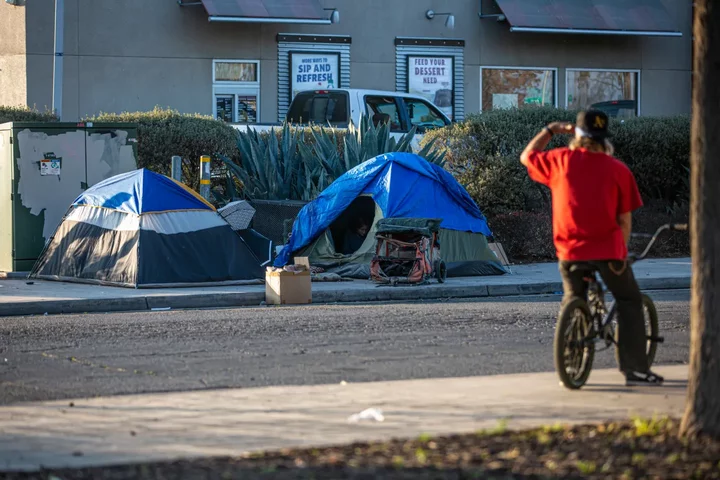OBITUARY: Marcy Foster, 1948-2024
LoCO Staff / Tuesday, May 21, 2024 @ 6:56 a.m. / Obits
Our
fun-loving, creative, and heart-felt friend passed on May 13, 2024
surrounded by loved ones in her home after a courageous battle with
pancreatic cancer. Marcy moved to Humboldt County in 1980 and as a
single-mother put herself through Humboldt State College for her BA
in Social Work and received her Masters of Social Work degree in 1991
from Sacramento State College. She worked for local non-profits
before landing a position at College of the Redwoods (CR) as an EOPS
counselor. Marcy had a positive impact on countless students at CR.
She was a beloved counselor and innovative in her approach. She was
instrumental in creating a special support program for former foster
youth and the formerly incarcerated. She retired in 2016 after 20
years.
Her greatest passions were gardening and creating art of all kinds. Her home garden is a mix of random pieces of art and flowering plants. She enjoyed woodworking, pottery, glass-blowing, mosaics, felting, crocheting, and watercolor paints. It was an adventure for her to shop garage sales to see what treasures she could bring home to renovate. She enjoyed traveling to warm places such as Belize and Maui to snorkel with turtles and exotic fish. Most of all, she treasured her dog companions over the last 50 years, leaving behind sweet Maisey.
She has a wide circle of friends who will miss her humor and listening skills. She is survived by her brother, Jon Foster (Colleen), niece Karin Dix (Eric), nephew Chris Foster (Evangelic), her son Ron Diltz (Julie), and granddaughter Dyanna Diltz. Marcy was blessed to have a very special relationship with Travis Arnold who became a loving kinship son and friend to her over the last 12 years.
Please consider donating to a local animal rescue foundation (https://www.cafanimals.org/) A Celebration of Life will be held TBD. Contact Suzi Hendry suzhyq@suddenlink.net.
###
The obituary above was submitted on behalf of Marcy Foster’s loved ones. The Lost Coast Outpost runs obituaries of Humboldt County residents at no charge. See guidelines here.
BOOKED
Today: 5 felonies, 11 misdemeanors, 0 infractions
JUDGED
Humboldt County Superior Court Calendar: Today
CHP REPORTS
0 Sr299 (RD office): Trfc Collision-No Inj
77285 Sr162 (HM office): Trfc Collision-No Inj
ELSEWHERE
Governor’s Office: Governor Newsom announces appointments
County of Humboldt Meetings: MIESC (McKinleyville Incorporation Exploration Subcommittee) Meeting Agenda
RHBB: Dangerous levels of cyanobacteria toxins identified in Big Lagoon
County of Humboldt Meetings: Fish & Game Advisory Commission Agenda - Regular Meeting
OBITUARY: Fran (Clark) Neufeld, 1938-2024
LoCO Staff / Tuesday, May 21, 2024 @ 6:56 a.m. / Obits
It is with sadness that the family of Fran (Clark) Neufeld announce her peaceful passing on May 2, 2024, at the age of 86. Fran spent her last days in peace at the Humboldt Hospice House in Eureka, which was bittersweet, as she was a loyal volunteer for over 20 years with Hospice in Ukiah. She was with her family, surrounded by nature and Redwood trees.
Fran was born in San Rafael and graduated from Petaluma High, class of 1955. During her life she lived many places (San Francisco, San Mateo, Cotati, Days Creek (Oregon), Potter Valley), finally settling in the Ukiah area with her family, where she lived most of her life.
Fran worked for many years at Bank of America as a teller where she met her lifelong friend, Yvonne Brown, as well as many other special friends. She later moved onto the Ukiah Senior Center where she found her passion for assisting the elderly, which led her to work for Area Agency on Aging where she was an Ombudsman. She was honored to help seniors and their families navigate the difficulties of end-of-life care. She was passionate about Hospice. She was exceptionally kind, loving and gentle with dying patients and their loved ones, knowing just how to bring peace and love into those moments when needed.
She loved spending time at the beach, searching for shells, listening to, and watching the waves. She called it her therapy. She also loved bird watching, which led her to volunteer at the Bird Rescue Center in Santa Rosa. Her favorite story to tell was when she captured an eagle with an injured wing and was able to release it once it was rehabilitated.
Fran was preceded in death by her husbands Dick Clark III and Roland Neufeld. She is survived by her children Dick Clark (Connie), Grant Clark (Theresa), and Ahna Hubner (Troy), as well as her sister Patricia Roux. She (Mimi/Gram) is survived by numerous grandchildren, great grandchildren, nieces, and nephews, as well as her close friends, Yvonne Brown, Diane Hunt, and Eddie Palmerin.
Graveside services will be held at a later date. Frans living wish was to support Hospice in any way; please consider donating in her name, in lieu of flowers, as to carry on her legacy of dedication to a wonderful organization close to her heart.
###
The obituary above was submitted on behalf of Fran Neufeld loved ones. The Lost Coast Outpost runs obituaries of Humboldt County residents at no charge. See guidelines here.
Eureka Man Sentenced to 10 Years in Prison for Possession of Child Pornography
LoCO Staff / Tuesday, May 21, 2024 @ 6:12 a.m. / Courts
Press release from the U.S. Department of Justice:
William [Scott] Wood has been sentenced to 120 months in prison following his conviction on a charge of possession of child pornography, announced United States Attorney Ismail J. Ramsey and Federal Bureau of Investigation (FBI) Special Agent in Charge Robert K. Tripp. The sentence was imposed by the Hon. Trina L. Thompson, United States District Judge, on May 17, 2024.
Wood, 62, of Eureka, California, pleaded guilty in October 2023 to one count of possession of child pornography, in violation of 18 U.S.C. § 2252(a)(4)(B) and (b)(2). He was originally indicted on that charge by a federal grand jury in December 2022.
According to the government’s sentencing memorandum, the defendant possessed more than 300 images and videos depicting child pornography on his electronic devices, including approximately 24 images depicting infants or toddlers and hundreds more depicting prepubescent children.
The government further argued in its sentencing papers that the defendant used social media to send child pornography to another individual, including images depicting infants or toddlers and prepubescent children engaged in sexually explicit conduct.
In addition to sentencing Wood to prison, Judge Thompson ordered the defendant to serve five years of supervised release to begin after his prison term is completed and to pay $35,000 in restitution.
Assistant United States Attorney Kelsey Davidson is prosecuting the case with the assistance of Sara Slattery. The prosecution is the result of an investigation by the FBI, with assistance from the Humboldt County Sheriff’s Office.
Two Fortuna Restaurants Cited For Attempting to Operate Without Water During City’s Planned Shutoff Last Week
LoCO Staff / Monday, May 20, 2024 @ 1:49 p.m. / Health
Last week, a pair of Fortuna restaurants were dinged by the Humboldt County Department of Health and Human Services’ Division of Environmental Health for continuing to operate despite not having access to a potable water supply due to the City of Fortuna’s planned shutoff.
After community complaints, both Pepper’s and McDonald’s were inspected and found to be out of compliance with health regulations due to the temporary conditions.
Both restaurants were allowed to reopen once water service was restored.
DOCUMENTS:
OFFSHORE WIND: Huffman Calls on Feds to Place Full-Time Tribal Liaison in California
LoCO Staff / Monday, May 20, 2024 @ 12:37 p.m. / D.C.
Huffman press conference on offshore wind after visit with tribes in March. File photo: Andrew Goff.
PREVIOUSLY:
###
Press release from the office of Rep. Jared Huffman:
U.S. Representative Jared Huffman (CA-02) sent an urgent letter to U.S. Bureau of Ocean Energy Management (BOEM) Director Elizabeth Klein requesting the agency place a senior-level official in California to oversee tribal participation in offshore wind development and be responsive to tribal needs.
Representative Huffman’s letter follows a recent visit with Secretary of the Interior Deborah Haaland to Humboldt, California – the site of the new offshore wind project – where they engaged with tribal leaders directly to hear concerns.
“Tribes in my California congressional district are witnessing the advancement of a significant new clean energy industry in offshore wind, which has both the promise of confronting climate change and the potential to impact native people and their lands and cultures. Most tribal nations have limited capacity to participate in offshore wind development in its early stages and have serious concerns about the deployment of the technology,” Huffman said in his letter.
“I call on BOEM again to expeditiously place an official on the ground in California to oversee tribal participation in offshore wind development. This is vital to the offshore wind effort and is responsive to the federal government’s trust obligations to tribes,” Huffman said.
As part of his advocacy for tribes, Rep. Huffman recently introduced a bill to increase public safety for tribal citizens by promoting cooperation and information sharing between tribal, state, and local law enforcement agencies.
To view a full copy of the letter, click here.
HIDDEN GEMS: Read Some Poems and a Short Story Written by Local Youth
Jacquelyn Opalach / Monday, May 20, 2024 @ 10:12 a.m. / :)
Hear, hear! Please witness this fruitful display of young literary accomplishment.
In a celebration Saturday, 49 local youth were awarded for their commendable submissions to the Redwood Writing Contest, a local competition for 3-12th graders. Their works of poetry, short story and nonfiction have been anthologized in a book illustrated by Cal Poly Humboldt student Lauren House and published by the Press at Cal Poly Humboldt. The anthology is available for purchase on Amazon for the humble price of $3.83, and a sneak peak of what’s in there is at the bottom of this post.
Some of these local awardees also entered their work in a state-wide writing contest hosted by the California Association of Teachers of English (CATE). Two of them won: Fuente Nueva student Ian Sowerwine for the poem “Cave Music” and Arcata High student Kona Bettenhausen for the short story “The Perfect Clearing.” We’ve attached them below for you to check out!
The Redwood Writing Contest is a collaborative effort. It’s organized by the Redwood Writing Project, a Cal Poly Humboldt based non-profit that offers free professional development on teaching writing to local K-12 teachers and hosts youth writing programs. This year, the Redwood Council of Teachers of English helped judge the entries, and the organization Humboldt Sponsors bought every winner a copy of the anthology.
For the 2024 contest, students responded to the prompt: “Hidden Gems: write about a moment when a person, an experience, or the world revealed something unexpected to you. What was the impact of that revelation?” The contest received a total of 194 submissions – more entries than ever before, Redwood Writing Project Director Nicolette Amann told the Outpost.
That said, the contest has inspired warming milestones in years past as well. Impressed by the 2023 contest entries of Hoopa Elementary students, 23rd Poet Laureate of the United States Joy Harjo visited the school [via zoom] to host a writers workshop last fall last spring. Harjo created and judged and selected 4th grade student Avery Benson as the winner. Then, two Hoopa Elementary 2023 CATE winners, 4th grader Avery Benson and 7th grader Carmen Ferris, were invited by the organization Turnaround Arts California to present their poems in Washington D.C. at the Kennedy Center earlier this year.
Anyway, attached below are a few of these pieces for your reading pleasure. Enjoy!
[We’ve updated this story following feedback from a former Hoopa Elementary teacher.]
###
Cave Music
By Ian Sowerwine, 2024
The always noise:
dripping water
from the low cave ceiling
jewels glittering from
below the dark water
millions of tiny animals
with their own tiny noises
oddly peaceful and quiet
but still
the always noise:
Cave Music.
The Night of the Acorn Festival
By Avery Benson, 2023
My Dad had to go to work
far away
the night of the Acorn Festival
the first time my sister and I were going
to wear traditional clothing
The maple bark skirt scratched my legs
Maggie gave me a cap woven of white bear grass
and black maidenhair fern
to wear on my head
The deer hide belt hung heavy around my waist
heavy olivessa, abalone and clam shells
heavy pine nuts and deer hooves
The long necklaces
made of dentalia and glass beads
made a “tic-tic” sound
swaying back and forth as I walked
I felt a special part of my culture
I missed my Dad
the night of the Acorn Festival
I Come From A Place Called Hoopa
By Carmen Ferris, 2023
I come from a place called Hoopa
My home is on the Rez
where I go to the store
and people say, “You are beautiful….
just like your mother.”
I carry the swallowtail necklace my grandfather made for me
on a silver chain around my neck
I offer the language of my people
He:yung
I know some words
not all
that’s better than none at all
I come from a place called Hoopa
I come from the bald eagle flying in the air
My home is with the black bear eating a steelhead
by the river
I carry a salmon on the end of my fishing pole
I offer to care for my people
I come from a place called Hoopa
If I were not Native who would I be?
How could I ever try to change
and be someone else but me
how could I ever want to change
the color of my skin or
where I come from
how could someone not want
to be Native
like me
The Perfect Clearing
A short story by Kona Bettenhausen, 2024
Part I: The Discovery
I was 8 years old when we discovered the clearing. My brother, Mark, was 6. Our house was in a neat little neighborhood enclosed by a dense wood, and Crawford Elementary School was about half a mile away. To get there we traversed the forest via a pedestrian path before entering the district of grocery stores, restaurants, gas stations, and the constant hum of traffic.
In the early winter mornings, the forest was too dark and snowy. On those days we put on our gloves and wool coats and took the far route to school. Mark would clutch my hand as we crossed snowy intersections. In summer we stayed out late with our playmates, exploring the forest. One bright afternoon in May, my brother and I were out playing in the woods near our house.
“What’s that?” I asked.
My brother was holding something in his fist. His palm unfolded to reveal a small yellow-painted rock.
“Just a rock,” he said.
“Where’d you find it?” I asked. I grabbed it from his hand and examined its chalky surface.
“It was in Gracie’s garden!” He pawed at my hand to get it back, but I cranked back my arm and hurled it towards the canopy.
“Hey!” Mark yelled, and we both watched it arc through the tree branches and land in the distant underbrush with a clash. Mark took off toward the noise, leaping over ferns and logs and I ran after him.
“Slow down, you’ll get hurt!” I called out, but by then Mark had already stopped and was now surveying the forest floor. He stomped over to the base of a large stump and picked up the golden object. He held it in the air like a trophy.
“That was too easy,” Mark announced. He wheeled back his arm and chucked the rock as hard as he could. Thus, a game started, in which each of us tried to throw it the farthest without losing it for good. The bright object was never hard to find amongst the brown-and-green terrain.
As we weaved through the forest, we ventured farther from our known world. The trees became more grand and vibrant, and the grass became tall. Up ahead, it seemed as though there was a wall of trees. Their branches tangled with each other and dense hedges surrounded their trunks. When it was my turn to throw the yellow stone, I catapulted it towards the thicket. Mark and I watched it disappear through a gap in the trees.
“You lost it!” he cried. We scampered over to the thicket and searched for the object, crawling under the massive hedges and dirtying our hair. Eventually, I found a tunnel through the hedge where I could see an empty clearing.
“Mark, come over here!” I saw the branches rustle and bend as Mark squirmed his way through the brush. As we pushed away the final leafy branches it felt like we had entered a portal. Our rock was lying in the center of a large dusty bowl, bordered by a lush, grassy creek. Large trees of all different kinds surrounded the clearing. Willows, cherry trees, beautiful blooming magnolias, and the tall oaks formed a wall around the entire place. Their branches seemed to arch over the clearing like a majestic gazebo of life. This was the most beautiful place I had ever seen in my life.
For the next two months, I would visit the clearing almost every day. After school, my friends and I would grab a soccer ball or some snacks and play in the clearing until our shadows stretched out across the dusty floor. Mark and his buddies would always tag along. My friends and I were older, so we tended to pick on them, claiming our territory and blocking it off from theirs. You needed the secret password to enter. Fallen branches were our swords. Old stumps were our fortresses.
Occasionally we would find garbage in the clearing. One time we uncovered an empty beer bottle filled with dirt. After emptying it, we used it as an instrument to sound the alarm for imaginary intruders. Other times, we used it to play keep-away or kick-the-can. Sometimes we just lay in the sunlight, in that grassy patch near the brook. No matter what happened, we always left the clearing with smiles on our faces.
Our fun was quickly extinguished when my father received a job offer in Boise, Idaho. Our family moved out within a month. I vividly remember our last visit to the clearing. The sun was already beyond the treetops. The clouds glowed above with the fading light of day. We took a final look around the clearing, before trudging back home.
Part II: The Return
I had a dream last night where I was in the clearing. I was there with Travis, Zeke, April, and more of my friends from high school. There was some kind of controversy but I can’t remember. An oak tree here, some bushes there, an old stump we used to climb in—fragments of an ancient memory.
For the last two days, Mark and I have been visiting our Aunt Beth who resides in Crawford. I haven’t been here since we moved away almost 10 years ago. I’ve gone through middle school and high school without even thinking about this place. Yet as soon as I returned, those memories that had been locked away were restored.
My family and I are sitting in a cramped booth at Felix’s Diner. The restaurant is much older than me, but we seldom went out to eat during my childhood. This space is filled with clamor. Babies are crying, silverware is clanking, and the jukebox is playing a broken record. I’m beginning to realize why we never came here. I nudge my brother, Mark.
“Look at them,” I murmur, nodding toward the family adjacent to us. Both parents have their heads bent down over their phones. I can see the screen’s colors reflecting off their eyes and faces. Mark leans his head out of the booth a little bit, and then quickly pulls it back in and puts his mouth to my ear.
“He’s watching TikTok,” Mark whispers. The couple’s child seems playful. She paws at the man’s arm, and we watch him produce an iPad from the bag beneath his chair. The child takes the iPad, and the family returns to their isolated state.
“It’s a good thing we didn’t raise them like that,” our mother says to Aunt Beth.
“Mark, you wanna go for a walk?” I ask.
“Sure. We’ll be right back, Mom.”
A bell jingles as I push open the glass door of the restaurant. Mark and I walk across the parking lot.
“Do you remember that spot we used to go to? In the forest?” I ask.
“Oh yeah, of course I do. Are we going there?”
“I just wanna see if it’s still there.”
We cross a barren road and set foot into the lush wilderness. The public forest has narrowed, due to the expansion of suburbia. The once-giant trees have shrunk down to saplings. I can see through the forest to an apartment complex on the other side. We follow the road down to a familiar cluster of madrones. The clearing should be in the center of this grove.
Mark and I walk through a gap in the wall of trees surrounding the clearing, and all of a sudden, we are children again. I remember my elementary school friends just as they were when I left them. Mark is 6 years old. He has a large grin on his face. His hands are muddied and his hair is tangled.
“Wow, this is crazy,” Mark exclaims, “it’s so much smaller than I remember.”
“Yeah I know, we were like this tall,” I say, raising my hand to my torso.
Mark starts strolling around the circumference of the clearing, looking at the trees and the changes to the landscape. I walk to the grassy area by the stream, remembering our old adventures here. Something clear and shiny catches a ray of sunlight through the grass.
We always knew that other people visited our clearing. There would sometimes be trash lying around, or abandoned clothing. I glance over at my brother. He is mature now, but I know he still has a pure memory of this place. I kick some dirt over the twisted latex condom lying on the ground. This is our safe space, and Mark should always know that.
Potential Tough-On-Crime Ballot Measure Promises Less Homelessness. Experts Aren’t Convinced
Marisa Kendall and Yue Stella Yu / Monday, May 20, 2024 @ 7:33 a.m. / Sacramento
Two tents set up across from Roeding Park in a small homeless encampment in Fresno on Feb. 10, 2022. Photo by Larry Valenzuela for CalMatters
Homelessness gets top billing in a measure likely to make it onto your November ballot. Whether the measure has anything to do with homelessness is debatable.
The initiative proponents are calling the “Homelessness, Drug Addiction, and Theft Reduction Act” would increase penalties for some drug and theft crimes, by rolling back Proposition 47 — the criminal justice changes California voters passed a decade ago. It also would force some people arrested three or more times for drug crimes into treatment.
But where does homelessness factor into this tough-on-crime measure? The initiative includes no money for housing, shelter or treatment beds — leading some experts to question how it would help get California’s more than 181,000 unhoused residents off the street in a state where recent research shows loss of income is the leading cause of homelessness. Nor does the measure allocate or create new funding sources to pay cities or counties to enforce it.
For Yolo County District Attorney Jeff Reisig, who helped author the proposed ballot measure, the philosophy is simple: The measure would slash the homeless population by pushing those struggling with drug addiction into treatment.
“The big part of this, which is the key to the program, is it’s going to be compelled,” Reisig said. “People are going to have to go through the program or accept the consequences.”
But according to Elliott Currie, a professor of criminology, law and society at the University of California Irvine, the measure is based on a false assumption.
“The theory is that people are homeless because we’ve been too lenient with drug addiction,” Currie said. “I think I can safely say that I don’t see one shred of serious evidence that that’s what’s going on.”
Did Prop. 47 increase homelessness in California?
The proposed ballot measure targets Prop. 47, which, when passed by voters in 2014, reduced certain theft and drug crimes from felonies to misdemeanors. In some circles, Prop. 47 now is being blamed for a perceived increase in crime – and a fierce debate is raging over whether, and how, to change it.
Backers of the measure, which is likely to qualify for the ballot after it recently submitted more than 900,000 signatures (about 547,000 valid ones are required), also blame Prop. 47 for California’s dire homelessness crisis.
In the decade that Prop. 47 has been in effect, homelessness in California has grown by more than half — and backers of the proposed ballot measure say the two are “directly connected.” They argue by watering down the legal consequences for drug use, Prop. 47 removed the incentives for homeless Californians to participate in mental health and drug treatment, and as a result, fewer are. Because of that, they argue, more people are living on the streets.
“One of the primary root causes of homelessness is serious addiction, which is debilitating and results in people not being able to function or even hold a job,” Reisig said in an interview with CalMatters.
It’s true that participation in drug courts dropped throughout the state in the wake of Prop. 47. In San Diego County, for example, more than 650 people went through drug court in the year before Prop. 47 passed. By 2021, it was down to just 255.
As evidence Prop. 47 is tied to homelessness, backers of the measure point to states with stronger drug laws and smaller homeless populations. Illinois, for example, has a homeless rate about five times less than California’s.
But there are a lot of other factors — especially housing costs — contributing to the state’s homelessness crisis. Fair market rent for a two-bedroom in Chicago is just $1,714 – nearly half the going rate in San Francisco. The San Francisco area rate increased 72% since Prop. 47 passed, hitting $3,359 this year, according to the U.S. Department of Housing and Urban Development.
The number one reason Californians end up homeless is a loss of income — not drug use, according to a UC San Francisco study
For some experts who study crime and homelessness, the ballot measure is baffling.
“I’m not aware of any data that shows a connection between Prop. 47 and homelessness,” said Charis Kubrin, a professor of criminology at UC Irvine. “So it’s a bit of a puzzle to me why they’re together like that.”
Blaming the state’s spike in homelessness on Prop. 47 is “preposterous,” said Sharon Rapport, director of California state policy for the Corporation for Supportive Housing. “All of the changes that the (ballot measure) is proposing have nothing, nothing whatsoever, to do with homelessness.”
The organization hasn’t even taken an official position on the measure, because, Rapport said, it’s not related to homelessness.
The number one reason Californians end up homeless is a loss of income — not drug use, according to a UC San Francisco study that provides the most comprehensive look yet at the state’s homelessness crisis. And in the six months before becoming homeless, the people surveyed were making a median income of just $960 a month.
That doesn’t mean drug use has nothing to do with homelessness. Nearly a third of people surveyed reported using methamphetamines three times a week, while 11% used non-prescribed opioids. Other studies have had varying results: a 2022 Stanford Institute for Economic Policy Research study, which cited research from multiple surveys across several states, showed 43% to 88% of the homeless population struggled with drug abuse.
Drug and alcohol overdoses are also the leading cause of death for homeless people nationwide, according to a February study examining mortality rates among unhoused people between 2011 and 2020.
But it’s clear not everyone on the streets has an addiction. Therefore, the proposed ballot measure would leave out a large chunk of the state’s homeless population.
If the measure helps even a third of California’s 181,000 unhoused residents — that’s a huge number, Reisig said.
“I’ll take that,” he said. “I’ll take that number to try and get those people well, and to get them reintegrated, and to keep them out of jail and prison, and keep them from dying on the street of overdose or murder.”
This measure might help some people get sober, said Benjamin Henwood, director of the USC Center for Homelessness, Housing and Health Equity Research. But for many people, that won’t be enough to end their homelessness, he said. While being sober might make someone more likely to get a job, it won’t make housing any less expensive.
“The question is: Once treatment is up, where do they go?” he said.
Under this measure, the answer to that question will depend on each individual county and how much, if any, housing they make available for people coming out of treatment.
How would the Homelessness, Drug Addiction, and Theft Reduction Act work?
If the proposed ballot measure is approved by voters, certain repeat drug offenses could be prosecuted as a “treatment-mandated felony.” That means the third time someone is arrested for a drug offense, they could be given a choice between jail or mandatory addiction and mental health treatment.
The measure says people participating in mandatory treatment also would be offered “shelter, job training, and other services designed to break the cycle of addiction and homelessness.” But it doesn’t say how any of that would be paid for. It would be up to counties to decide whether to offer shelter and other services, and how to fund them, Reisig said.
“That will have to be deployed in each county to the extent they can do it,” he said.
The measure also doesn’t specify how the mandatory drug and mental health treatment would be funded.
But without guaranteeing those housing services, the measure could actually worsen homelessness, Currie said. There’s already a robust jail-to-homelessness pipeline in California: 43% of those surveyed in the UCSF study were in jail or prison, or on probation or parole, in the six months before they became homeless.
“Anybody who says you’ve got to solve the problem by putting more people behind bars, but you then don’t say anything about how you’re going to help them re-enter when they come out — I think that’s pretty bogus,” Currie said.
The measure also doesn’t specify how the mandatory drug and mental health treatment would be funded.
Resources for treatment already are stretched thin in California. In a 2022 survey by the state’s Department of Health Care Services, 70% of California counties reported “urgently” needing more residential addiction treatment, while nearly 40% didn’t have any residential facilities at all.
In addition to providing no new funding, the proposed ballot measure could actually end up reducing funds for the very programs it’s trying to bolster, according to a report from the independent Legislative Analyst’s Office. That’s because Prop. 47 saved the state money in criminal justice costs by diverting people away from prison and jail. Those savings are earmarked for projects that provide mental health and substance use treatment (nearly $104 million was awarded between 2017 and 2020, and another $96 million between 2019 and 2023).
By gutting Prop. 47 and funneling more people into the state’s jails and prisons, the Legislative Analyst estimates the proposed ballot measure would eat away at those savings and increase criminal justice costs by as much as tens of millions of dollars per year. That could mean less money for mental health services and addiction treatment.
Reisig dismissed that worry, saying, at least in Yolo County, where he is district attorney, Prop. 47 savings haven’t made much difference. “There’s literally nothing that I fear losing through this program,” he said.
There is some new money available from other pots. In March, California voters approved a $6.4 billion bond to pay for 6,800 beds in facilities treating mental illness and addiction, and as many as 4,350 housing units for people who need those services. The state is set to start awarding that money in the spring and summer of 2025, Newsom said this month.
But at the same time, to plug a yawning budget deficit, Newsom has proposed cutting funds from the Behavioral Health Bridge Housing Program, which provides beds for people who need mental health and addiction services.
Currie said he is “skeptical” of the lack of funding mechanisms for treatment programs and other services to ensure homeless people stay off the streets post-treatment. That, he said, could burden counties that already struggle with insufficient funding for such services — one in five homeless people surveyed by UCSF researchers said they sought substance abuse treatment but failed to get it.
“You can’t just say, ‘Ok, you counties. Since you are swimming in so much money after all … we are going to mandate drug treatment for some people on top of the existing number of clients,’” Currie said.
The politics of homelessness
Some political strategists say the measure’s tie to homelessness represents the campaign’s attempt to capitalize on public concern about the problem. Homelessness is a top issue on California voters’ minds, according to a February 2024 statewide survey by the Public Policy Institute of California.
“This notion somehow that it addresses homelessness is deceptive and downright farcical,” said Garry South, a longtime Democratic consultant who has worked on ballot measures for more than 20 years.
Homelessness is ultimately due to a lack of housing, he argued, and measures aiming to address the problem without providing housing are “disingenuous.”
“You’ve heard the old saying ‘Putting lipstick on a pig,’” South said. “I’m not saying that this measure is a pig, but what I’m saying is it’s a standard procedure … to try to gussy it up with some reference or some provision that really strikes a responsive chord with voters when that’s not really what the initiative is about.”
If the measure appears before voters in November, “homelessness” won’t be in the title they see on their ballots. The official title of the measure, chosen by the state attorney general, is: “Allows felony charges and increases sentences for certain drug and theft crimes.”
A lot of thought, politics, and sometimes even litigation goes into drafting the title and summary of a ballot measure. While proponents of a proposition want to entice voters with their description, it’s ultimately the state attorney general’s job to make sure the language is fair.
Even without mentioning homelessness, South said the ballot measure could still “pass on its own merits.” He, for one, would likely vote for it as a way to decrease crime.
Drugs and homelessness
Tom Wolf, who has experienced both homelessness and addiction first hand in San Francisco, said the proposed ballot measure has great potential to help people who were like him.
An opioid addiction cost Wolf his job and his home, and landed him on the streets of San Francisco’s Tenderloin neighborhood in 2018. He said he worked as a “holder” for nearby drug dealers, safeguarding their stash of narcotics in case they were busted by the police. Sometimes he stole razor blades from a nearby Target and sold them for money to buy heroin.
Wolf says he was arrested on drug charges five times within three months, and was released back to the street each time. The sixth time he was arrested, the judge let him sit in jail for three months, where he got sober. Wolf finally called his brother, who said he would bail him out if Wolf went to drug treatment. Wolf agreed. He says that if he had been given the choice between jail and treatment the last time he was picked up, he would have chosen treatment.
In June, Wolf will have six years sober. He’s now an advocate for drug policy reform, and works as director of West Coast initiatives for the Foundation for Drug Policy Solutions.
“That accountability piece was the key to me getting off the street,” he said, “getting sober, becoming willing to accept an opportunity to go to treatment and give recovery an honest try.”
###
The CalMatters Ideas Festival takes place June 5-6! Find out more and get your tickets at this link.
CalMatters.org is a nonprofit, nonpartisan media venture explaining California policies and politics.







